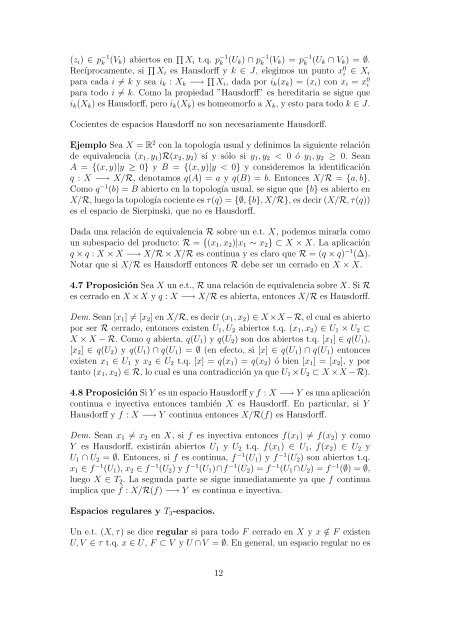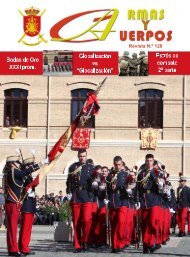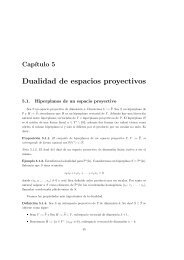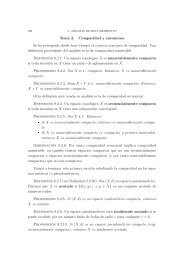TOPOLOGÍA GENERAL II - Universidad de Zaragoza
TOPOLOGÍA GENERAL II - Universidad de Zaragoza
TOPOLOGÍA GENERAL II - Universidad de Zaragoza
You also want an ePaper? Increase the reach of your titles
YUMPU automatically turns print PDFs into web optimized ePapers that Google loves.
(zi) ∈ p −1<br />
k (Vk) abiertos en Xi t.q. p −1<br />
k (Uk) ∩ p −1<br />
k (Vk) = p −1<br />
k (Uk ∩ Vk) = ∅.<br />
Recíprocamente, si Xi es Hausdorff y k ∈ J, elegimos un punto x 0 i ∈ Xi<br />
para cada i = k y sea ik : Xk −→ Xi, dada por ik(xk) = (xi) con xi = x 0 i<br />
para todo i = k. Como la propiedad ”Hausdorff” es hereditaria se sigue que<br />
ik(Xk) es Hausdorff, pero ik(Xk) es homeomorfo a Xk, y esto para todo k ∈ J.<br />
Cocientes <strong>de</strong> espacios Hausdorff no son necesariamente Hausdorff.<br />
Ejemplo Sea X = R 2 con la topología usual y <strong>de</strong>finimos la siguiente relación<br />
<strong>de</strong> equivalencia (x1, y1)R(x2, y2) sí y sólo si y1, y2 < 0 ó y1, y2 ≥ 0. Sean<br />
A = {(x, y)|y ≥ 0} y B = {(x, y)|y < 0} y consi<strong>de</strong>remos la i<strong>de</strong>ntificación<br />
q : X −→ X/R, <strong>de</strong>notamos q(A) = a y q(B) = b. Entonces X/R = {a, b}.<br />
Como q −1 (b) = B abierto en la topología usual, se sigue que {b} es abierto en<br />
X/R, luego la topología cociente es τ(q) = {∅, {b}, X/R}, es <strong>de</strong>cir (X/R, τ(q))<br />
es el espacio <strong>de</strong> Sierpinski, que no es Hausdorff.<br />
Dada una relación <strong>de</strong> equivalencia R sobre un e.t. X, po<strong>de</strong>mos mirarla como<br />
un subespacio <strong>de</strong>l producto: R = {(x1, x2)|x1 ∼ x2} ⊂ X × X. La aplicación<br />
q × q : X × X −→ X/R × X/R es continua y es claro que R = (q × q) −1 (∆).<br />
Notar que si X/R es Hausdorff entonces R <strong>de</strong>be ser un cerrado en X × X.<br />
4.7 Proposición Sea X un e.t., R una relación <strong>de</strong> equivalencia sobre X. Si R<br />
es cerrado en X × X y q : X −→ X/R es abierta, entonces X/R es Hausdorff.<br />
Dem. Sean [x1] = [x2] en X/R, es <strong>de</strong>cir (x1, x2) ∈ X ×X −R, el cual es abierto<br />
por ser R cerrado, entonces existen U1, U2 abiertos t.q. (x1, x2) ∈ U1 × U2 ⊂<br />
X × X − R. Como q abierta, q(U1) y q(U2) son dos abiertos t.q. [x1] ∈ q(U1),<br />
[x2] ∈ q(U2) y q(U1) ∩ q(U1) = ∅ (en efecto, si [x] ∈ q(U1) ∩ q(U1) entonces<br />
existen x1 ∈ U1 y x2 ∈ U2 t.q. [x] = q(x1) = q(x2) ó bien [x1] = [x2], y por<br />
tanto (x1, x2) ∈ R, lo cual es una contradicción ya que U1 ×U2 ⊂ X ×X −R).<br />
4.8 Proposición Si Y es un espacio Hausdorff y f : X −→ Y es una aplicación<br />
continua e inyectiva entonces también X es Hausdorff. En particular, si Y<br />
Hausdorff y f : X −→ Y continua entonces X/R(f) es Hausdorff.<br />
Dem. Sean x1 = x2 en X, si f es inyectiva entonces f(x1) = f(x2) y como<br />
Y es Hausdorff, existirán abiertos U1 y U2 t.q. f(x1) ∈ U1, f(x2) ∈ U2 y<br />
U1 ∩ U2 = ∅. Entonces, si f es continua, f −1 (U1) y f −1 (U2) son abiertos t.q.<br />
x1 ∈ f −1 (U1), x2 ∈ f −1 (U2) y f −1 (U1)∩f −1 (U2) = f −1 (U1 ∩U2) = f −1 (∅) = ∅,<br />
luego X ∈ T2. La segunda parte se sigue inmediatamente ya que f continua<br />
implica que ˆ f : X/R(f) −→ Y es continua e inyectiva.<br />
Espacios regulares y T3-espacios.<br />
Un e.t. (X, τ) se dice regular si para todo F cerrado en X y x /∈ F existen<br />
U, V ∈ τ t.q. x ∈ U, F ⊂ V y U ∩ V = ∅. En general, un espacio regular no es<br />
12





